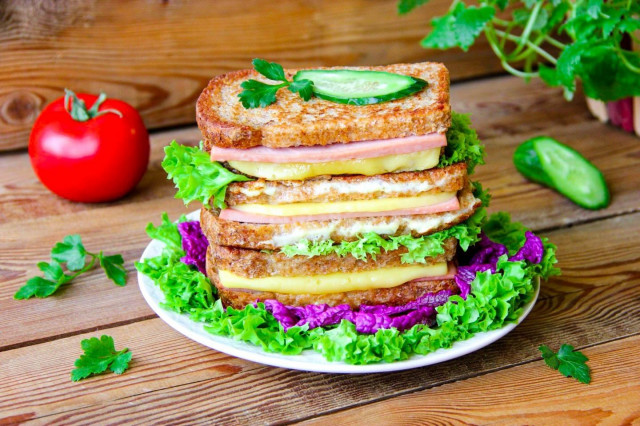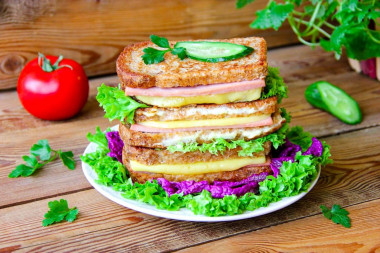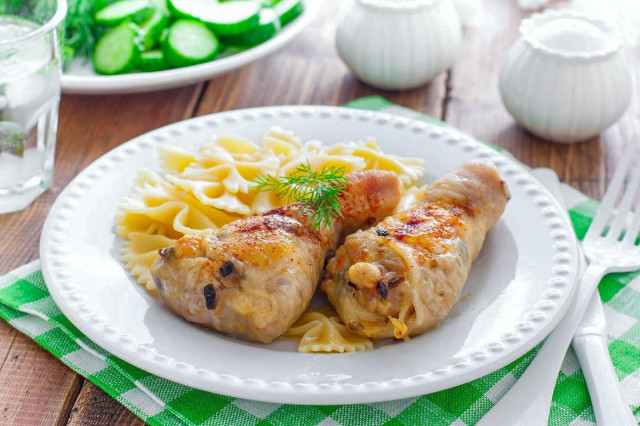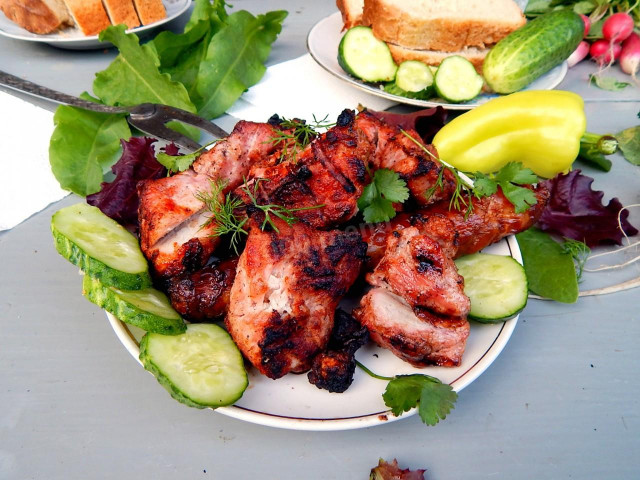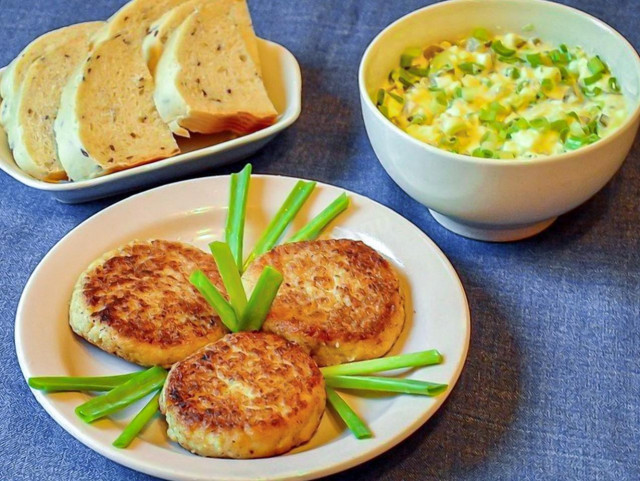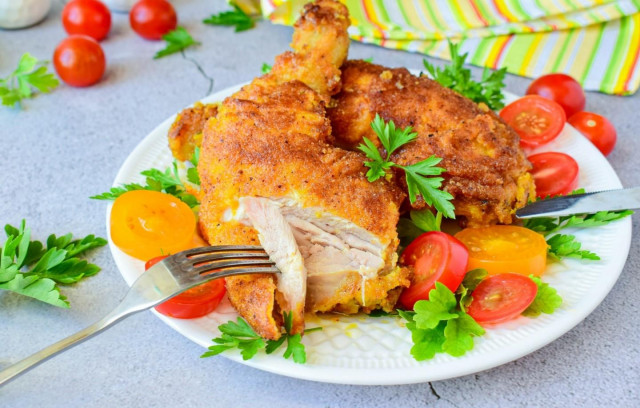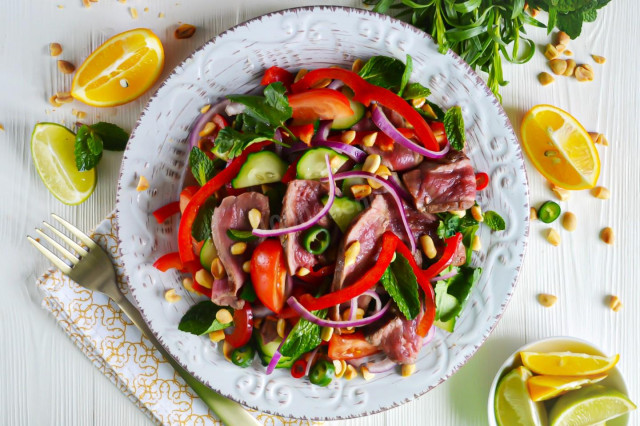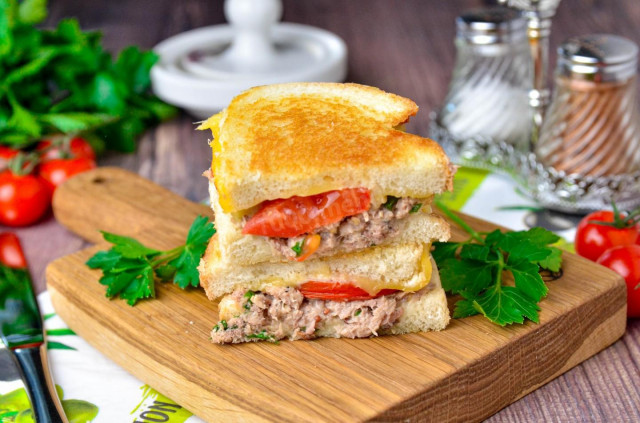Composition / ingredients
Step-by-step cooking
Step 1:
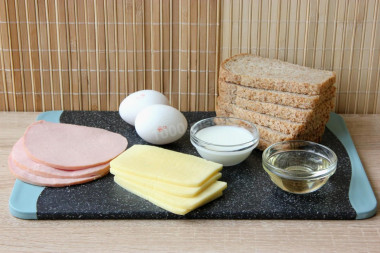
How to make sandwiches in a frying pan with sausage and cheese? Prepare the products. You can take any bread to taste — white, rye, whole grain, a loaf, a loaf, and in the form of a saika will do. Any cheese for this dish is suitable — hard, semi-hard, soft, like mozzarella. The main thing is that it is delicious, high-quality, without milk fat substitutes and melts well. It is advisable to take boiled sausage, you can take ham.
Step 2:
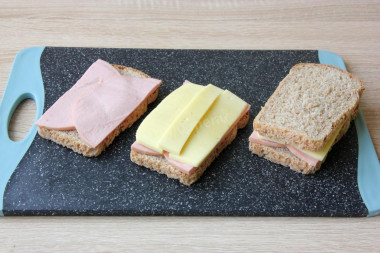
Bread, if it was not sold in sliced form, cut into slices 0.8-1cm thick. Cut the sausage thinner, 0.4-0.5 cm thick. Cut the cheese into approximately equal pieces with the sausage. It is very convenient to use already sliced cheese. Then lay the products in layers on the bread — first the sausage, then the cheese and cover the top again with a piece of bread. I cut the sausage in half and put it in an even slice outside — so the sandwiches look neater.
Step 3:
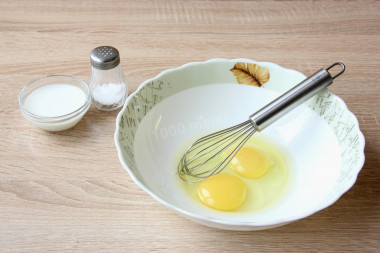
Put the frying pan on medium heat to warm up and cook the pie. In a wide bowl, whisk the eggs well with milk and salt. Liezon is not prepared in advance and is used immediately. Consider how salty the sausage and cheese are, perhaps you will need to add quite a bit of salt. If desired, you can add a little spices to the liezon — pepper, paprika.
Step 4:
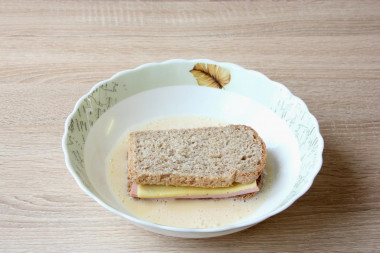
When the pan is hot, pour oil into it, heat it over medium heat. Dip the sandwiches in the leeson, alternately with each side. Do not keep it in it for a long time, but at the same time the bread should be soaked all over. (This amount of lemon is enough for exactly three sandwiches, so if necessary, increase the norm).
Step 5:
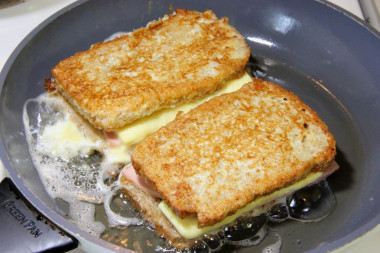
Fry the sandwiches alternately on each side until they are browned and the cheese melts. At the end, it is advisable to cover the pan with a lid, at least for a minute. Sandwiches are fried very quickly.
Step 6:
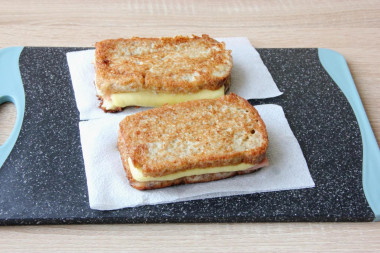
Put the finished sandwiches on a napkin so that the excess oil is absorbed. Serve them hot with tea or coffee, also sandwiches can be cut in half and wrapped in sheets of any green salad or add fresh cucumber, tomato slices to the top. Bon appetit!
Be sure to wash the eggs before use, as even the seemingly clean shell may contain harmful bacteria. It is best to use food detergents and a brush.
Use oil with a high smoking temperature for frying! Any oils are useful only until a certain temperature is reached - the point of smoking, at which the oil begins to burn and toxic substances, including carcinogens, are formed in it.
Unrefined oils, with rare exceptions, have a low smoking point. There are a lot of unfiltered organic particles in them, which quickly begin to burn.
Refined oils are more resistant to heating, and their smoking point is higher. If you are going to cook food in the oven, on a frying pan or grill, make sure that you use oil with a high smoking point. The most common of the oils with a high smoking point: refined varieties of sunflower, olive and grape.
To check whether the oil has warmed up well enough in the pan, you can do it in a simple way. Lower a wooden spatula into it. If bubbles have gathered around it, then you can start the frying process.
Caloric content of the products possible in the composition of the dish
- Whole cow's milk - 68 kcal/100g
- Milk 3.5% fat content - 64 kcal/100g
- Milk 3.2% fat content - 60 kcal/100g
- Milk 1.5% fat content - 47 kcal/100g
- Concentrated milk 7.5% fat content - 140 kcal/100g
- Milk 2.5% fat content - 54 kcal/100g
- Chicken egg - 157 kcal/100g
- Egg white - 45 kcal/100g
- Egg powder - 542 kcal/100g
- Egg yolk - 352 kcal/100g
- Ostrich egg - 118 kcal/100g
- Dutch cheese - 352 kcal/100g
- Swiss cheese - 335 kcal/100g
- Russian cheese - 366 kcal/100g
- Kostroma cheese - 345 kcal/100g
- Yaroslavsky cheese - 361 kcal/100g
- Altai cheese 50% fat content - 356 kcal/100g
- Soviet cheese - 400 kcal/100g
- Cheese "steppe" - 362 kcal/100g
- Uglich cheese - 347 kcal/100g
- Poshekhonsky cheese - 350 kcal/100g
- Lambert cheese - 377 kcal/100g
- Appnzeller cheese with 50% fat content - 400 kcal/100g
- Chester cheese with 50% fat content - 363 kcal/100g
- Edamer cheese with 40% fat content - 340 kcal/100g
- Cheese with mushrooms of 50% fat content - 395 kcal/100g
- Emmental cheese with 45% fat content - 420 kcal/100g
- Gouda cheese with 45% fat content - 356 kcal/100g
- Aiadeus cheese - 364 kcal/100g
- Dom blanc cheese (semi-hard) - 360 kcal/100g
- Lo spalmino cheese - 61 kcal/100g
- Cheese "etorki" (sheep, hard) - 401 kcal/100g
- White cheese - 100 kcal/100g
- Fat yellow cheese - 260 kcal/100g
- Altai cheese - 355 kcal/100g
- Kaunas cheese - 355 kcal/100g
- Latvian cheese - 316 kcal/100g
- Limburger cheese - 327 kcal/100g
- Lithuanian cheese - 250 kcal/100g
- Lake cheese - 350 kcal/100g
- Gruyere cheese - 396 kcal/100g
- Vegetable oil - 873 kcal/100g
- Bread "darnitsky" - 206 kcal/100g
- Premium wheat flour bread - 254 kcal/100g
- Wheat flour bread of the 1st grade - 226 kcal/100g
- Wheat flour bread of 2 grades - 220 kcal/100g
- Wheat bread made from coarse flour - 250 kcal/100g
- Rye bread from floured flour - 189 kcal/100g
- Rye bread from wallpaper flour - 181 kcal/100g
- Protein bran bread - 182 kcal/100g
- Wheat protein bread - 242 kcal/100g
- Grain bread - 231 kcal/100g
- Bread "doctor" - 232 kcal/100g
- Orlovsky bread - 211 kcal/100g
- Ukrainian bread - 213 kcal/100g
- Simple loaf - 248 kcal/100g
- Loaf of premium flour - 265 kcal/100g
- City rolls made of grade I flour - 254 kcal/100g
- City bun - 261 kcal/100g
- Butter bun - 252 kcal/100g
- Simple steering wheels - 336 kcal/100g
- Bread - 254 kcal/100g
- Salt - 0 kcal/100g
- Sausage "amateur" - 291 kcal/100g
- Sausage "Ukrainian" - 404 kcal/100g
- Diabetic sausage - 254 kcal/100g
- Sausage "doctor" - 197 kcal/100g
- Diet sausage - 170 kcal/100g
- Dairy sausage - 252 kcal/100g

